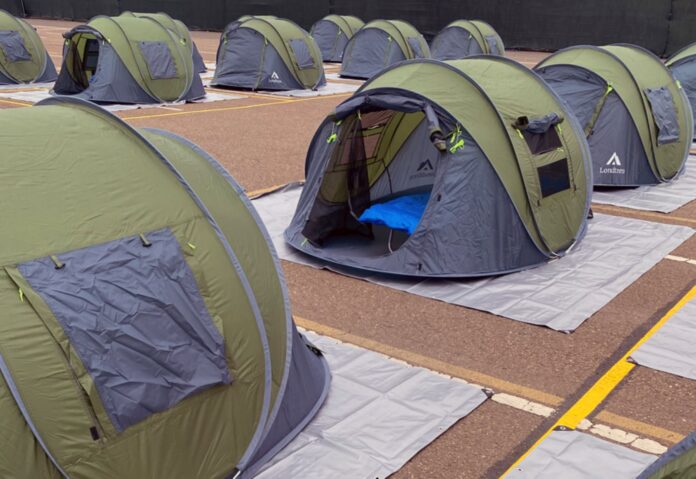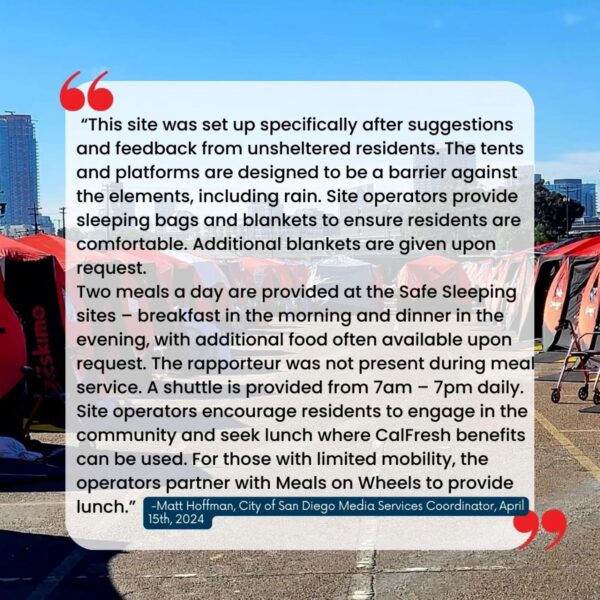
By Macy Meinhardt, Voice & Viewpoint Staff Writer
The San Diego City Councilmembers voted unanimously on a half a million increase last Monday towards the safe sleeping site in Golden Hill. With over 10,000 people on the street due to housing shortages, the decision is one of multiple initiatives Mayor Todd Gloria has “fast-tracked” into motion recently to curb the growing crisis.
The safe sleeping program, a legal camping option for the homeless, opened back in June 2023. The site provides 130 tents for referred homeless individuals to sleep in overnight, with the ultimate goal of getting them into housing. In the nine months since opening, it has served 577 individuals. 19 of those people have made it into permanent housing, with a 3.3% housing rate, according to the City.
Initially, program operations were scheduled and budgeted only for six months. However, due to substantial interest and demand, staff and supporters of the program spoke in support of the site extension. Noting consistent wraparound lines from people waiting to get into the site, which is located on the City’s Operation Yard, on 20th & B. The program also hosts another safe sleeping site in Balboa Park.
“There’s always room for improvement. But, realistically this is one of the least expensive options that the city has, and it is providing a solution for many people that cannot accept living in a congregate shelter, which can be very challenging,“ said John Brady with Lived Experience Advisors.
Just recently the announcement of Mayor Todd Gloria’s proposed budget reveals a $200 million structural deficit in the annual fund, but a specific increase by $26.6 million on homeless services.
The program came in tandem with the city’s unsafe campaign ordinance, which illegalized homeless encampments in certain public areas. The move made headlines for being one of the harshest crackdowns on homelessness in the state. Subsequently, it sparked an ongoing debate about the ethics of “criminalizing” homelessness, a discussion that persists even a year later.
When the ban came into effect, thousands of residents signed a petition-“oppose the criminalization of homelessness in San Diego”. In addition, hundreds of local scholars and educators sent a letter to the City condemning the ban. Their letter cited examples from an SDSU report documenting “the negative consequences of the use of police to enforce anti- homelessness laws.”
“SDSU researchers show that unhoused San Diegans report experiencing a frequent lack of respect during encounters with officers of the San Diego Police Department, including overt racism, sexism, and homophobia, as well as a failure to offer basic services during encounters,” the letter reads.
Black San Diegans and other vulnerable populations are overrepresented among individuals in need of sheltering assistance. Tied to systemic inequities, Black San Diegans make up 28% of the homeless population in our region even though they only represent 5% of the overall population.
Therefore the site, operated by Dreams for Change nonprofit, comes in lieu of streets, parks, and canyons no longer being an option—without citation at least— for unsheltered people to go. As one of two sites within San Diego, the safe sleeping website states that the program provides guests with two meals a day, portable bathrooms, and showers.

The site is described as an outdoor, low barrier shelter that caters to individuals with unique needs, such as accommodating couples, households, and pets.
“The City understands investing in different types of shelter options is key to meeting unhoused individuals where they are. From what we’ve seen, this program is reaching individuals who have historically been hesitant to accept shelter services, and therefore, we know connections to other resources and services may take additional time.” said City Spokesperson Matt Hoffman, in a comment to Voice & Viewpoint.
In addition to this, when people enter the Safe Sleeping Program, guests must sign a code of conduct which stipulates drug/alcohol use and possession onsite is not permitted.
“While the safe camping site is not what anybody would want for the residents of San Diego. It does meet an individual need for folks. I just want to make sure I get this clear, there are people that are lining up to get into this site because it offers such a unique opportunity that meets their individual needs,” said District 7 Councilmember Raul Campillo.

Despite meeting these needs, as well as an improvement in the presence of homeless encampments downtown, the site still bears skepticism.
Back in January, a United Nations special rapporteur on the Right to adequate housing, took a tour of the temporary shelter site. In a comment to Voice and Viewpoint, Professor Balakrishnan Rajagopal observed that the camps “fall far short” of the international basic standards for shelter.
“In my view, safe sleeping camps do not meet safe and adequate standards for housing or even shelter. Shelter is an emergency response while housing is a human right on its own,” said Mr. Rajagopal.
According to recent media reports, four people have died in the safe sleeping sites in the past year, their cause of death is unknown at this time.
On the site itself Mr. Rajagopal noted that utilized “fishing tents” are too small to be habitable and have no roof for shelter against inclement weather. In regards to the food offered he said, “The food rations appeared to be meager while the residents were expected to take infrequent shuttles to find their own food during day.”
In response to these findings, this is what the city said:

To read the full response from the city on the United Nations Special Rapporteur’s comments, click here.
In the meantime, the site stands as a temporary stop-gap measure till at least June, while the City and Mayor feverishly work on finding the ultimate long term solution; building more housing.
Macy Meinhardt is a part of the inaugural cohort of California Berkeley Local News Fellowship serving as the local reporter for Voice & Viewpoint .


